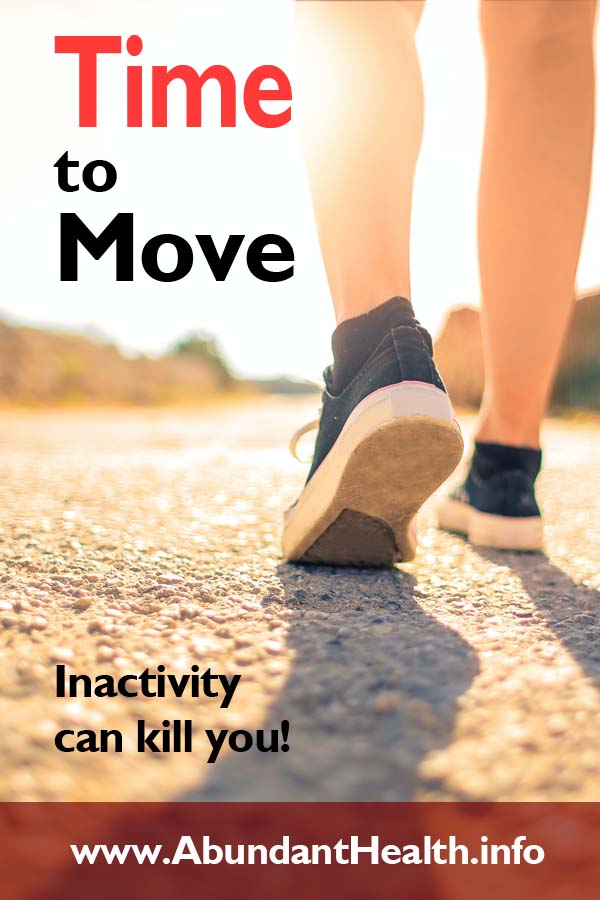With over 50 million American adults practicing chronic inactivity, this habit could be “the biggest public health problem of the 21st century.”1) Blair, S., PED, Speaking at the American Psychological Association’s 117th Annual Convention.

A well-known health educator, Ellen White, once wrote, “Perfect health depends upon perfect circulation.”2) White, E., Healthful Living, p. 30. The scientific validation of this profound statement is becoming increasingly clearer. Researchers are now understanding that inactivity decreases the circulation of the blood and causes the body to begin shutting down. The Australian journal Circulation found that a person’s risk of dying increases as much as 11 percent for every hour of television watched per day—even when researchers controlled for age, sex, education, smoking, BMI (body mass index), and leisure-time exercise. Pennington Medical Research Center has shown that inactivity gives us a 54-percent increased risk of heart disease, so it is no surprise that the sedentary lifestyle of Americans is partly responsible for heart disease being the number-1 cause of death. People who spent more than four hours a day sitting in front of the T.V. had an 80-percent greater likelihood of dying from cardiovascular-related disease than those who watched less than 2 hours per day.3) Dunstan, D., et al., Television Viewing Time and Mortality: The Australian Diabetes, Obesity and Lifestyle Study. Circulation: JAHA, 121:384-391, 2010.
Today’s Trend
In the 1950s, roughly 75 percent of the workforce was engaged in manual labor, while the other 25 percent was comprised of clerical or managerial jobs that were chiefly sedentary. However, in the last 50 years, this ratio has completely reversed. At present, about 80 percent of the workforce are in sedentary positions or positions that require only light activity. We are now living in a generation that will “RUST OUT” rather than “WEAR OUT,” in spite of the fact that the pressures of modern society may be in certain respects more stressful and demanding than those of previous generations.
Who’s the Slowest?
Are you curious to know what regions have the highest level of inactivity? It appears that parts of Appalachia and the South are the most inactive, according to research findings in which more than 29 percent of adults in those areas indicated that they get no exercise or physical activity outside of their work. Areas of the West Coast, Colorado, and Minnesota are among the regions demonstrating the highest activity levels.4) CDC (Center for Disease Control).Not only are states affected, but ethnic and racial groups as well. Hispanic women who did not complete high school are at the greatest risk of inactivity, at 32.3 percent. Black men with a college education had the lowest prevalence of inactivity, at four percent. Hispanics and non-Hispanic Blacks reported similar levels of inactivity, but both groups were more inactive than their Caucasian counterparts. Women tended to report being less physically active than men.5) Marshall, S., et al., Study Links Social Class and Physical Inactivity. JACSM, 39(1):44-51, 2007.
Why Sitting Still Can Kill
Although we don’t need to be told by the experts that sitting around too long can lead to a potbelly or backache, we may be imbibing false concepts of the benefits that can be gained by exercise done to offset these sedentary habits. Do you think that going to the gym three to four times a week can make up for sitting down most of the day? Marc Hamilton, an inactivity researcher at the Pennington Biomedical Research Center, states, “Exercise is not a perfect antidote for sitting.” Useful work, however, offers many benefits, including an increased tendency to resist disease. It is interesting how exercise (or lack of it) has played a role in the escalation of diabetes. Inactivity researchers (yes, there is such a thing) at Mayo Clinic have confirmed that being sedentary is disastrous to one’s metabolism: just 24 hours of being sedentary can result in a 40-percent reduction in insulin’s ability to uptake glucose. This makes sitting around an especial no-no for anyone with diabetes.

Exercise is very important to the powerhouses of the cells, called mitochondria. These little organelles help convert ATP (adenosinetriphosphate) into the energy required for our bodily functions. Significantly, the amount of physical activity in which we engage determines to a great degree, the number, size, and efficiency of our mitochondria. This generally means that the more physically active you are, the more energy you will have. The old saying “Use it or lose it!” holds true— not only for the muscles but on a cellular level as well! Sitting burns a mere one calorie per minute— which correlates to a 67-percent decrease in caloric expenditure, compared to walking. At this lowered metabolic rate, the breakdown of lipids and triglycerides slows significantly, the helpful HDL cholesterol is depleted, and insulin effectiveness rapidly decreases. Although poor posture has a definite effect on our health, it is not the only ill of sedentary behavior. The amount of time that we spend sitting, as well as the activity in which we are engaged while sitting, are also problematic. For example, the physiological effects of watching an intense game of football for two hours is not going to be the same as that of having a meaningful conversation with a good friend for the same length of time.
Tips for Sedentary Workers
You may not be able to move out of your sedentary job, but you can move while in your sedentary job. If you are at a desk, do some periodic stretching; climb the stairs instead of riding the elevator; do many little errands for your office workers—they will love you for it! Try some deep-breathing exercises; take advantage of your breaks, walk around if you are using a cell phone, or just take a little time to clean your office or water the plants. There are thousands of ways you can keep active in a sedentary job, so just take some time to think of creative ideas for keeping on the move!
Inactivity and Longevity
Alpa Patel, an epidemiologist at the American Cancer Society, tracked the health of 123,000 Americans between the years 1992 and 2006. Patel estimated that on average, people who sit too much shave a few years off their lives. The men in the study who spent 6 hours or more per day of their leisure time sitting had an overall death rate that was about 20 percent higher than men who sat for 3 hours or less per day. What was interesting is that the same statistics did not apply to women: those who sat for more than 6 hours a day had about a 40 percent higher overall death rate, or twice that of men.6) Vlahos, J., New York Times, April 14, 2011.
Exercise and Calories
Dr. Levine, a professor of medicine from Mayo Clinic and considered to be one of the most authoritative researchers of inactivity, was interested in finding out why eating an extra 3,500 calories didn’t necessarily put on an extra pound of fat. He discovered that the small movements of daily activity that would not technically be considered as exercise also play a role in the utilization of calories by the body. He coined the acronym NEAT, which stands for non-exercise activity thermogenesis, a name for the concept of reaping large benefits from thousands of minor movements each day. Although it doesn’t account for all the aspects of caloric expenditure, we have to admit that it is a NEAT part of the equation!
Effects on the Mind
Exercise is not just an activity to improve heart function, weight or blood-sugar control; it also has a profound effect upon one of the most important organs of the human body, the brain. “Continued inactivity is one of the greatest causes of debility of body and feebleness of mind. Many are sick who ought to be in very good health and thus in possession of one of the richest blessings they could enjoy.”7) White, E., Counsels on Health, p. 95. Mental workers and students, would you like your mind to be more efficient and vitalized? Get adequate physical activity! “The time spent in physical exercise is not lost. A proportionate exercise of all the organs and faculties of the body is essential to the best work of each. When the brain is constantly taxed while the other organs of the living machinery are inactive, there is a loss of strength, physical and mental. The physical system is robbed of its healthful tone, the mind loses its freshness and vigor, and a morbid excitability is the result.”8) White, E., Counsels for the Church, p. 160.

Not only is bodily activity necessary for a healthy mind, but also for a victorious spiritual life. Useful labor increases the strength and force of the will so that we can choose the right and shun the wrong. It is no surprise that our Savior, who conquered and vanquished sin at every step, spent a life of prayer coupled with one of constant activity, working, walking from village to village healing, and teaching.
As we contemplate His life of active service, maybe the Lord is calling you to walk more closely with Him. Why not take the next step of faith, be it ever so small or great, and journey on in the “path of life” that leads to “fullness of joy” in His presence forevermore?9) The Bible, Psalm 16:11. It will be sure to be a move worth making!
This article was published originally in the Journal of Health and Healing, a publication of Wildwood Institute.
Lee is currently working as a physiology and health educator at Wildwood Health Institute and gives lectures across America on various health-related topics.
References
| ↑1 | Blair, S., PED, Speaking at the American Psychological Association’s 117th Annual Convention. |
|---|---|
| ↑2 | White, E., Healthful Living, p. 30. |
| ↑3 | Dunstan, D., et al., Television Viewing Time and Mortality: The Australian Diabetes, Obesity and Lifestyle Study. Circulation: JAHA, 121:384-391, 2010. |
| ↑4 | CDC (Center for Disease Control). |
| ↑5 | Marshall, S., et al., Study Links Social Class and Physical Inactivity. JACSM, 39(1):44-51, 2007. |
| ↑6 | Vlahos, J., New York Times, April 14, 2011. |
| ↑7 | White, E., Counsels on Health, p. 95. |
| ↑8 | White, E., Counsels for the Church, p. 160. |
| ↑9 | The Bible, Psalm 16:11. |
Leave a Reply